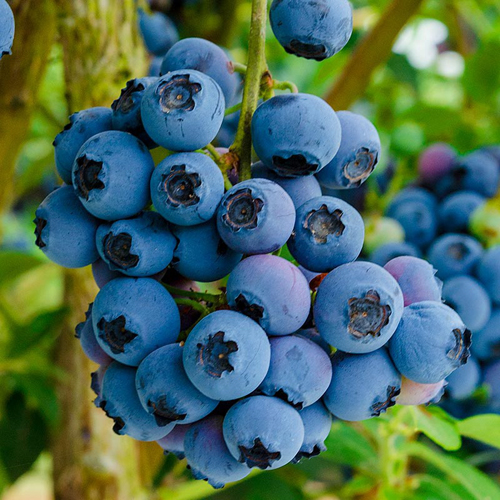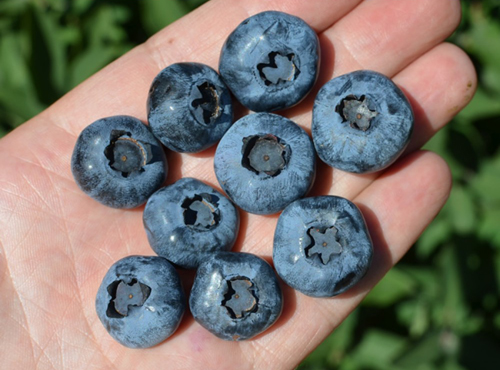Blueberry variety River
Until recently, this was a completely incomprehensible new product on the market. Great interest was fueled by the fact that the variety was from a completely outlandish place for us - distant New Zealand. And the name itself, consonant with the Russian word "river", added mystery to the new blueberry. Many gardeners really thought that this is a variety with Slavic roots. And the author of the article himself at first wondered: "What kind of river is this and where does it flow?" But it turned out to be simple. Reka means "sweet" in Maori, the national language of the indigenous population of New Zealand. But whether the name corresponds to reality and what else will the New Zealander enchant us with - more on this in our article below.

History of creation
In 1969, as a result of an agreement between P. Bates (Ruakura) and A. D. Draper (USDA), the seeds from the cross-pollination of the best American varieties were donated to Ruakura. The aim of the research carried out by scientists in New Zealand was to develop plants that are best suited to local conditions. As a result of scientific work, 10 elite species were selected from more than 1000 blueberry seedlings. Some of them were descended from Berkeley and Blurey, and some from Bluecrop and Erliblu. Just from their crosses and as a result of careful selection and evaluation carried out over the years, 3 new New Zealand varieties were selected - Puru, Niu and, of course, Reka. The work was completed by the breeder Franklin H. Wood. In 1982, he re-planted the seedlings to once again confirm the commercial value of the new products. The copyright holder is Maftech North Ruakura Agricultural Research Center, Hamilton, New Zealand. The patent was granted in 1986.
Description
River blueberry (Reka) very early ripening. In the south, the collection begins in mid-June, and already in the Leningrad region it will sing from July 26-30. In other regions, for example, in the Middle Lane, from late June to early July. In general, in terms of time, our heroine is similar to the variety Duke... The ripening time can be significantly influenced by spring weather. A cold spring can delay the onset of ripening up to 2 weeks.

A plant with a powerful vigor of growth, the River bush is high, the stems are strong, resilient, erect, the habit of the bush is open. The height is mainly 1.3-1.8 meters, less often up to 2 meters, the width is 1.2-1.7 meters. Lateral shoots are strongly branched and thickened. Therefore, regular pruning of the stems and cutting of thin, weak branches are required, which negatively affect the future harvest and the size of the berries. Young shoots of blueberry are slightly pubescent, greenish with a pink tint. With age, closer to autumn, they acquire a pinkish-red, "brick" color.
Leaves are dark green with a glossy sheen, on short petioles, dense. The upper surface is smooth, with slightly depressed veins, and the underside is slightly pubescent in the region of the central vein. Leaves are on average 63 mm long and 36 mm wide. They are ovoid, with solid edges, pointed at the ends. The river can be successfully used in landscape design to decorate the site - in the fall, the foliage is painted in a spectacular burgundy-red color. And by autumn, numerous shoots acquire a reddish-brick hue, which adds even more decorative effect to the entire plant.
The flowers are numerous, white with a pink blush and a faint pink stripe on the side. Elongated-cylindrical, bell-shaped, with petals bent back, collected in large clusters of 8-12 flowers. In the south, blueberries bloom in April-May. In other regions in May-June. The river blooms for a long time - up to 1 month. It is a self-pollinated variety, but is recommended for increasing the number of ovaries, flavor and fruit size by cross-pollination with other varieties. Moreover, for cross-pollination, specimens with similar flowering periods are needed. For example, early Duke, Patriot... Also, our heroine is a good honey plant, the bush attracts a lot of bumblebees and bees.

The root system is fibrous, densely branched, lacking suction hairs.It penetrates into the ground to a depth of 40 cm. It grows well on light sandy soils, peat and heavier clay loams. But the variety for successful development and disclosure of all the potential inherent in it requires compliance with the required level of soil acidity - pH 4.5-4.8.
Blueberry berries are deep dark blue in color with a pronounced grayish-blue bloom, with a small perianth and a small dry scar after harvest. They are firm, dense, with an elastic elastic skin. The pulp is juicy, with small, almost imperceptible seeds, light green color, pleasant, medium-rich aroma. It takes up to 10 days from the moment the fruit is colored to the set of sweetness and taste.
Berries are medium to large in size, rounded, slightly flattened. The average fruit diameter is 1.4-1.6 cm, less often up to 2.0 cm, and the weight is 1.6-1.8 grams, less often up to 2 grams. Moreover, the average weight is an order of magnitude less than 2 other New Zealanders - Puru with 2.2 grams and Nui with 2.1 grams. But the total yield of the River is almost 2 times higher in comparison with them. The berries are collected in relatively open, numerous clusters, mainly of 8-12 fruits; adults and well-developed plants often have clusters containing 20 fruits.
The diameter and weight of blueberry fruit varies with the season. Early harvests are larger and heavier than later samples. A high percentage of total productivity occurs at the beginning of the season. The berries are really delicious. Well-ripe fruits have excellent taste, rich, multifaceted, with hints of grapes and strawberries. They are very sweet, but sometimes a slight savory sourness may be present.

The river is gaining strength by the 5th year of cultivation. Requires regular and careful pruning. If pruning is insufficient, the bush will thicken strongly. As a result, there will be many small berries that will take a very long time to sing and gain flavor. The variety builds up its potential rather quickly and begins to yield crops. Productivity after reaching 3 years of age is 4.4 kg, and by the 5th year of life, blueberry yield (in New Zealand) was 9.3 kg per bush. The average productivity in the world is 6-10 kg per bush.
The fruits are characterized by good keeping quality and transportability. When transported over short distances, they do not wrinkle or flow. The fruits are moderately resistant to falling off the bush when fully ripe. In addition, the berries are characterized by an average resistance to cracking.
Our heroine is a valuable find for both commercial and amateur cultivation. Fruits of universal use: great for personal consumption, market sales, processing, freezing, are actively used in cooking.
The river is one of the fastest growing and most adaptable varieties in the world. But it shows itself best in regions with a temperate climate, with planting in places well-lit by the sun. This blueberry is more tolerant of high soil moisture than many other varieties. Resistant to diseases and pests. Possesses good frost resistance. Withstands a drop in temperature to -35 ° C without freezing shoots and buds. According to the United States Department of Agriculture (USDA), frost resistance zones are 4-7. Our heroine is in many ways similar to her parent - Blyukrop. It is similar to him in the strength of the bush's growth, aroma, winter hardiness and the size of the berries.
The scientific work of St. Petersburg scientists is interesting (especially for residents of the northern regions of our country). The research was carried out in 2013–2015 on the basis of the educational and experimental garden of St. Petersburg State Agrarian University. Planting material (11 varieties) was imported from Belarus and Finland. The acidity of the planting soil was 3.6, which is the optimal indicator for growing blueberries. Planting scheme for two-year-old seedlings: 1.5 meters between plants in a row with a row spacing of 2.0 meters. The landing date is August 2013.The counts and observations were carried out according to the "Program and methodology for the study of varieties of fruit, berry and nut crops."
According to the data of 2015, the blooming of vegetative buds on the River occurred on 04.05, the beginning of the growth of the main shoots - 05.06, the beginning of the growth of branching shoots from 13.05. The beginning of flowering from 05.06, the beginning of ripening of berries - 30.07, full ripening - 10.08. All shoots have completed their growth by the date 30.08. The leaves began to turn red from 21.08, completely colored 10.10. Leaf fall begins at 15.10, ends at 23.10. As a result of phenological observations, it was found that all the studied varieties of tall blueberries correspond to seasonal rhythms, form the yield of berry products and fit into the growing season of the Leningrad region. Specifically, the River showed itself as early maturing. After the winter period of 2015, even a slight freezing of shoots was not noted on it. The safety of plants after coming out of winter was 100%. In 2014, freezing was also not noticed at all.
The variety received one of the highest tasting ratings (4.4 out of 5 points). And it was also found that the fruits of the River have a rich biochemical composition.
According to the results of 2015, the variety has formed 6 new main shoots (formation shoots) and 52 branch shoots (sidewalls). The length of the leaves was 5.8 cm, the width was 2.7 cm.The average weight of the blueberry berry was 1.6 grams, the diameter was 1.4-1.6 cm.
Author: Maxim Zarechny.








